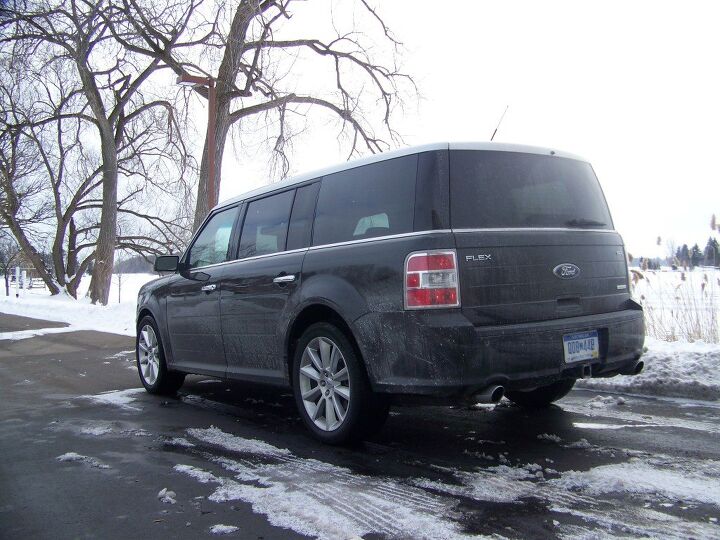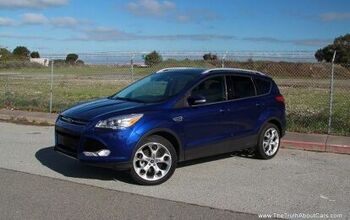Review: Ford Flex Ecoboost Take Two
A few years ago Ford decided that its survival depended on making bold moves. They decided to stop simply doing what they’d always done. Well, at least some of the time. One bold move: replace their minivan with the world’s largest Scion xB. Another: instead of offering a V8, twin-turbocharge and direct inject a V6. Then combine the two to offer a 355-horsepower family hauler that really hauls. Intriguing. But does the Ford Flex EcoBoost make sense?
The interior is unchanged from the un-boosted Flex, except for shift paddles added to the steering wheel. Just as well, since this is perhaps the best interior in any Ford. It’s in harmony with the exterior and the vehicle’s mission. Materials, if not quite luxurious, are good enough to not come across as cheap. There’s plenty of room in the high-mounted first two rows for four adults (five with the bench version). The amount of headroom borders on ridiculous. The big cushy seats provide long-distance comfort, though four-way adjustable lumbar support would be a welcome addition. The outer inch of the seating surfaces in the Flex SEL appears to be vinyl—wear shorts in hot weather and your skin sticks to this inch but not the rest of the surface. In the more expensive Flex Limited, the entire seating surface seems to be genuine cow hide. Unlike in the related Lincoln MKT, there’s also enough room for a pair of adults in the third row—but they’ll have to sit knees up. The “way back’s” main shortcoming: it only seats two, not three as in minivans and GM’s large crossovers. Each outboard seat gets its own reading light—popular with the kids.
The Flex also excels at hauling cargo. Every seat except the driver’s quickly and easily folds to form a flat surface. Even with the third row up we had enough space behind it for all our luggage last summer—the deep well otherwise used for stowing the third-row seat gives the Flex an advantage over most competitors.
Not once during 1,500 miles with my family in a rented Flex last summer did I catch myself thinking, “What this thing really needs is more power.” Instead, I found that 262 horsepower hitched to a 6-speed automatic is sufficient to motivate 5,000 pounds of vehicle, people, and luggage. After all, the Flex is a minivan substitute, not a sports anything. So what’s the point of another 93 horses?
A week with the EcoBoost left me still searching for much of a point. The stopwatch will report zero-to-sixty in about six seconds. But subjectively, 355 horses have rarely felt slower owing to the Flex’s size, shape, quietness, and mass. The sound the engine makes at full tilt doesn’t encourage aggressive throttle applications. Even if the engine had a “come hither” voice, hooning a Flex just doesn’t feel right. At part throttle in the midrange, the Ford EcoBoost V6 sounds downright pedestrian, even a tad cobby. On the plus side of the ledger, nothing about the feel of the engine provides even a hint that it’s turbocharged.
Responses aren’t exactly snappy, but this is due to the transmission more than anything else. One thing I did wish for in the regular Flex was a way to hold the transmission in a specified gear—with six-speed automatics Ford gave up on the old 5-4-3-2-1 gear selector. With the EcoBoost, you get not only the ability to manually shift the transmission, but paddles with which to do it. While I don’t see using these often for aggressive driving, the paddle shifters could come in handy in hilly terrain.
Ah, yes; hilly terrain. There’s none to be explored near where I live. If there had been…or if I’d driven the Flex EcoBoost well above sea level…or if I’d had a trailer hitched to the back, then the EcoBoost no doubt would have earned its keep.
What about the “Eco” part? In the front-wheel-drive Flex I averaged 23 miles per gallon with a mix of 10 percent city, 90 percent highway. Ford claims no penalty for the EcoBoost engine. The trip computer reported 17 MPG in suburban driving and 22 in highway driving, quite good for a 355-horsepower 5,000 pound brick. Based on the EPA ratings, the EcoBoost’s mandatory all-wheel-drive and not the engine itself is responsible this drop.
Still surprisingly good for such a powerful, heavy vehicle.
With all-wheel-drive the Flex chugs through deep snow as if it’s not even there. A few times I drove with one set of tires on the plowed road and the other two on the unplowed shoulder—just because I could. Goodyear Eagle RS-As aren’t known as a spectacular snow tire, but when carrying 5,000 pounds they grip well. Couldn’t feel a thing through the wheel or the seat of my pants. Problem is, you never feel much through the steering wheel on any road surface. Communicative Ford’s EPS system is not. Weighting is pretty good, though; for what the Flex is, it’ll do.
The regular Flex feels a touch floaty. For the EcoBoost the suspension has been lowered 0.4” and firmed up as much as the chassis engineers felt they could get away with. Consequently, the float is gone, body motions feel much more tightly controlled, lean in turns is minimal, and grip is decent until the outside front tire overloads and the vehicle lapses into oh-so-safe understeer. Still not an invitation to hoon—even with a tighter suspension the Flex feels huge and far from agile. Credit not only its size but the distant upright windshield. Think that the Scion xB and Nissan cube feel surprisingly roomy? Well, apply the same configuration to the truly large vehicle, and you’ll feel like you’re navigating more than driving. On top of these factors, I’ve yet to drive a car on Ford’s D3 platform that didn’t feel ponderous. I suspect it’s the suspension geometry. The Mazda CX-9 and even the largest-and-heaviest-in-class GM Lambdas feel more tossable (though this is most certainly relative). For the sake of evaluation I pushed the Flex hard enough around a curvy circuit to sink fuel economy below ten. But would I ever drive a Flex this way otherwise? Probably not; there’s not much fun to be had here. The primary benefit of the tighter
suspension is in driver confidence and safety on challenging roads, not in driver enjoyment. The chassis is certainly competent, but not entertaining.
There is a cost to the EcoBoost’s additional body control. The ride never becomes downright harsh, but the EcoBoost feels more jittery over the small stuff and reacts more abruptly to larger bumps. Pairing the stiffer suspension with 19-inch wheels might yield a better compromise, but with the EcoBoost only 20s are offered. In any Flex and in the related Lincoln MKT impacts often reverberate through the less-than-rigid body structure.
I’m a fan of the Flex. The styling keeps growing on me, and the room, comfort, and interior flexibility are indisputable strengths. But does it make sense to spend another $3,800 to EcoBoost it? In the end, this decision becomes a surprisingly practical one. I’m aware that some people are entranced by the combination of a massive vehicle with a powerful engine—a friend had Lingenfelter supercharge his Hummer H2. For me, a pair of turbos and stiffer suspension bits do not transform Ford’s supersized brick into a driving machine. Driven the way such vehicles are typically driven, where they’re typically driven, the extra power simply won’t come into play. And I didn’t much enjoy pushing the Flex EcoBoost harder. But if you need more power and control for mountains, high altitudes, or towing, then the Flex EcoBoost makes more sense than a normally-aspirated V8 would have.
Ford provided the vehicle, insurance, and one tank of gas for this review.
Michael aresh owns and operates TrueDelta, an online provider of auto pricing and reliability data.
Michael Karesh lives in West Bloomfield, Michigan, with his wife and three children. In 2003 he received a Ph.D. from the University of Chicago. While in Chicago he worked at the National Opinion Research Center, a leader in the field of survey research. For his doctoral thesis, he spent a year-and-a-half inside an automaker studying how and how well it understood consumers when developing new products. While pursuing the degree he taught consumer behavior and product development at Oakland University. Since 1999, he has contributed auto reviews to Epinions, where he is currently one of two people in charge of the autos section. Since earning the degree he has continued to care for his children (school, gymnastics, tae-kwan-do...) and write reviews for Epinions and, more recently, The Truth About Cars while developing TrueDelta, a vehicle reliability and price comparison site.
More by Michael Karesh
Latest Car Reviews
Read moreLatest Product Reviews
Read moreRecent Comments
- Lorenzo They won't be sold just in Beverly Hills - there's a Nieman-Marcus in nearly every big city. When they're finally junked, the transfer case will be first to be salvaged, since it'll be unused.
- Ltcmgm78 Just what we need to do: add more EVs that require a charging station! We own a Volt. We charge at home. We bought the Volt off-lease. We're retired and can do all our daily errands without burning any gasoline. For us this works, but we no longer have a work commute.
- Michael S6 Given the choice between the Hornet R/T and the Alfa, I'd pick an Uber.
- Michael S6 Nissan seems to be doing well at the low end of the market with their small cars and cuv. Competitiveness evaporates as you move up to larger size cars and suvs.
- Cprescott As long as they infest their products with CVT's, there is no reason to buy their products. Nissan's execution of CVT's is lackluster on a good day - not dependable and bad in experience of use. The brand has become like Mitsubishi - will sell to anyone with a pulse to get financed.







































Comments
Join the conversation
"...Ford claims no penalty for the EcoBoost engine.." BS, PURE BS. Ford marketing doublespeak. Absent the turbocharging a DFI engine can have a ~12:1 compression ratio. With a proper DFI CR this engine could have improved hwy FE in the range of 20-30% As it is today this engine will run in detuned/derated mode 99% 0f the time, sacrificing off-boost STELLAR FE for rarely needed(***) WOT HP/torque. *** Except for those with a "boy-racer" mentality and deep enough pockets (and a bit stupid!)to pay the $4,000 to $7,000 preminum to get an Ecoboost equipped Ford.
"...With all-wheel-drive the Flex chugs through deep snow as if it wasn't even there..." This particular type of F/awd does not engage the rear drive capability except during low speed acceleration or during low speed turns. This is a pre-emptive measure since those are the PRIME times wheren FWD vehicles otherwise are the most HAZARDOUS to drive in wintertime adverse, slippery roadbed, conditions. You will soon discover that the F/awd system is virtually useless for the times of real need since the TC system is so highly tuned to take INSTANT measures, dethrottling and braking, to restore traction on the front wheels. Loss of traction on the front wheels is such a DIRE threat to live and limb it MUST be abated ASAP. I would suggest to anyone owning a vehicle with this type of F/awd system that a switch be added to disable the system, thereby extending FE. Only enabling the system, DIRECTLY engaging the system, bypassing the automatic mode entirely, when road conditions warrant All-Wheel-Drive functionality.